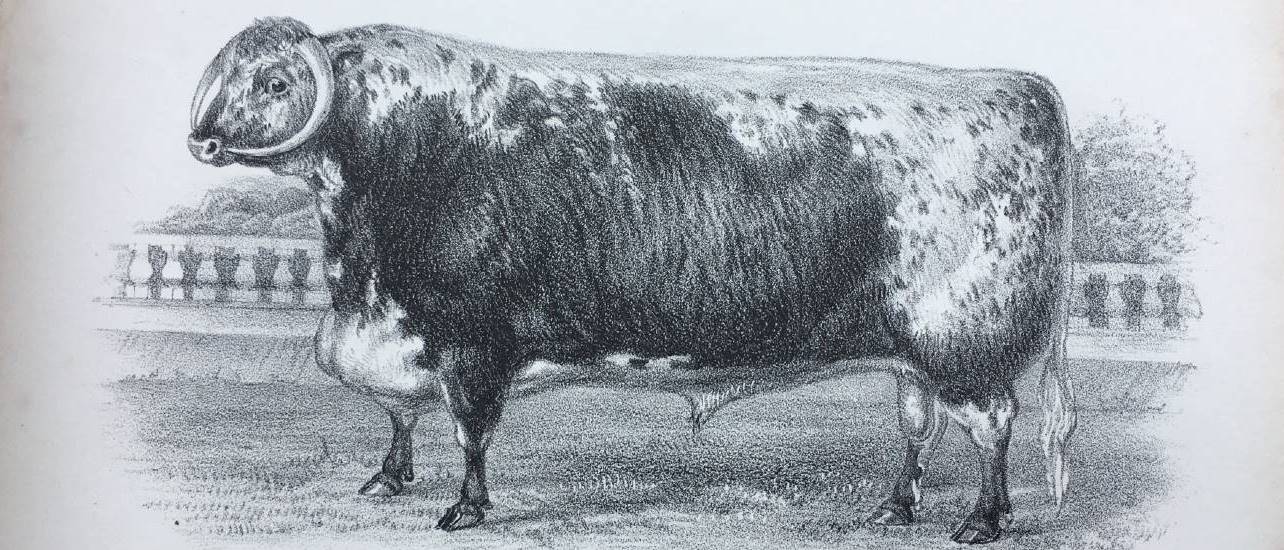
Breed History
It is around 10,000 years since cattle became domesticated. All modern breeds descend from the Aurochs, a now extinct wild ox - cousin of the European bison. By 4000 BC longhorned cattle were being used as sacrificial animals in many religions throughout the world, whilst shorthorned cattle were used more for agricultural purposes.
The ‘Hamitic’ Longhorn spread throughout western Europe, via Spain, from Africa around 2000 BC. These influenced the development of many breeds, including Longhorn, White Park, Welsh Black, Kerry and Carmargue as well as the native Spanish breeds and their descendents exported to America (including the Texas Longhorn). Remains of these animals have been found in Neolithic sites throughout Europe.
The Longhorn was originally used as a triple purpose breed—draught, beef and milk producer. It was valued as a producer of high quality milk. In fact it was claimed that more butter could be made from Longhorn milk than from the same amount of milk produced by any other breed. Longhorns are now used almost solely as a beef animal.
Although it is unrelated to the Texas Longhorn it resembles it in having horns of a distinctive and eye-catching character. They sweep backwards from the convex forehead in a variety of styles, are fine in texture and free from any black colouration. The Longhorn’s coat varies in colour from dark plum-brindle to light red-roan. A white stripe, of ‘finching’, down the back, tail and underside, plus white patches on each thigh are characteristic of the breed.

From Robert Bakewell to the present day
The Longhorn was first popular in the Craven district of Yorkshire, before being ‘improved’ by Robert Bakewell of Dishley Grange, near Loughborough in Leicestershire. Bakewell took over the tenancy of the farm from his father in 1760. He based his methods on the principal of inbreeding which was already proving highly successful with racehorses. Bakewell played a great part in the formation of the pedigree system. He bought two Longhorn heifers from Mr Webster of Canley, near Coventry, and a bull from Westmorland, whose offspring he inbred intensively to produce early maturing animals with a carcass that had a high proportion of fat and relatively little bone. He was not bothered with milk yields and one of his sayings was “all is useless that is not beef”.
The fame of Bakewell’s Dishley Longhorns, also known as the Improved Longhorn or New Leicester breed, spread rapidly. By 1810 the majority of beef cattle in the Midlands were of Improved Longhorn type. Around 1817 Longhorns were exported to Australia where they formed the bases of the beef herds there, and some to the USA where they had very little influence even on the Texas Longhorn which was based on Spanish stock.
With the emergence of the Shorthorn cattle, the glory of the Longhorn was short-lived. But a few enthusiasts throughout the 1800s and early 1900s kept the breed going. This was partly due to their decorativeness but also because of their excellent ability to produce good cross-bred animals. A Longhorn-Hereford heifer won the gold medal at Smithfield in 1847 as best female of any breed. Post World War II there were just some 50 registered Longhorns.
With the foundation of the Rare Breeds Survival Trust in the 1970's the Longhorn, along with many other endangered native breeds, found an advocate. The breed slowly grew in popularity thanks to a dedicated core of breeders and in 2005 the breeding population had grown to such an extent that the breed was no longer 'rare'. Since then numbers of both cattle and breed society members have continued to grow apace. Today there are over 12,000 registered females owned by around 500 Society members.
In the 21st Century the breed has come into it's own and farmers recognise it's outstanding qualities as a suckler cow and producer of quality beef.
For further articles written by Society members about the history of the breed, please go to the Breed History section of the knowledgebase.
(Pictured is a photograph from the Society's first Herdbook, printed in 1878. The bull is 'Conqueror 3rd' bred by His Grace the Duke of Buckingham and Chandos. The bull was a winner at RASE Birmingham, Liverpool and Bristol in 1876, 1877 and 1878)